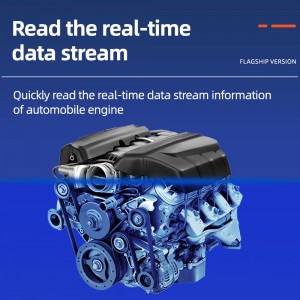The Live Data Stream (or Real-Time Data) feature in OBD2 diagnostics allows users to monitor real-time sensor and system data from a vehicle’s onboard computer.
This data is transmitted through the OBDii port and provides insights into the vehicle’s operational status, helping identify issues, optimize performance, and ensure compliance with emissions standards.
Key Practical Uses for Everyday Drivers of OBD2 Scanner Tool
- Engine Health Monitoring
- Track critical parameters like RPM, coolant temperature, and fuel system status to detect anomalies (e.g., overheating, misfires).
- Fuel Efficiency Optimization
- Analyze air-fuel ratios, oxygen sensor readings, and throttle position to adjust driving habits and improve mileage.
- Early Fault Detection
- Spot irregularities (e.g., erratic sensor values) before they trigger a Check Engine Light (CEL), avoiding costly repairs.
- Emission Compliance
- Monitor catalytic converter efficiency and oxygen sensor performance to ensure eco-friendly operation.
- Troubleshooting Assistance
- Verify repairs or diagnose intermittent issues (e.g., stalling) by observing live data during driving.
Important Live Data Parameters for Drivers with OBD2 Code Reader Tool
- Engine RPM
- Reveals engine load and helps detect misfires or transmission issues.
- Coolant Temperature
- Critical for preventing overheating; ideal range: 85–105°C (185–220°F).
- Oxygen Sensor (O2 Sensor) Readings
- Indicates fuel mixture efficiency; abnormal values suggest fuel system or catalytic converter problems.
- Short-Term & Long-Term Fuel Trim (STFT/LTFT)
- Shows fuel adjustment by the ECU; extreme values (+/-10%) may indicate air leaks or sensor faults.
- Throttle Position Sensor (TPS)
- Monitors accelerator pedal input; erratic values hint at throttle body or sensor issues.
- Vehicle Speed Sensor (VSS)
- Helps diagnose speed-related issues (e.g., ABS or transmission errors).
- Mass Airflow (MAF) Sensor Data
- Measures air intake; deviations affect power and fuel economy.
- Battery Voltage
- Ensures charging system health (normal range: 12–14.5V).
Why It(Live Data Stream Funcion of OBD2 scanner) Matters to Drivers
- Proactive Maintenance: Catch issues early (e.g., rising coolant temps) to avoid breakdowns.
- Cost Savings: Diagnose minor problems before they escalate.
- Performance Insights: Optimize driving behavior for better fuel economy.
- Transparency: Verify mechanics’ diagnoses using real-time data.
By leveraging live data, drivers gain a deeper understanding of their vehicle’s health, empowering them to make informed decisions and maintain reliability.
Post time: May-10-2025











